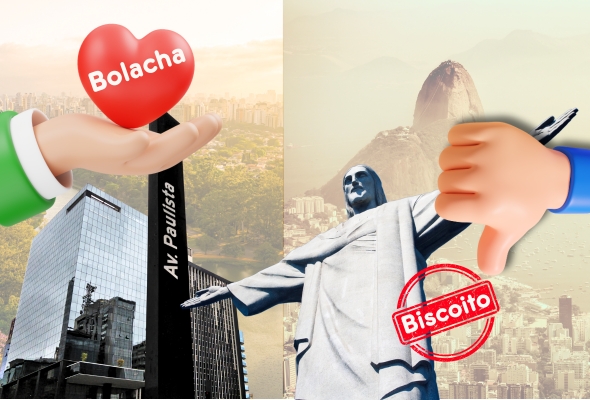What is the difference between cookie and biscuit?
The Delight that Divides Brazil (and Unites the World!)
Sweet or savoury, crunchy or soft, thin or thick… In Brazil, the mere mention of “bolacha” or “biscoito” can generate heated debates and separate friends!
But what is the difference between the two? And which side of the war is right?
SPOILER TIME: there isn’t one! And it looks like we’re going to remain on this side of the bridge, thinking we’re right! Team São Paulo, thank you! hehehe
For those who don’t know the story, we Paulistas love to tease the Cariocas and vice versa… it’s a tradition. But rest assured, my best friend is from Rio and we’re more than friends: we’re sisters by choice.
So, my proposal in this blog is that we embark on a delicious adventure to unravel the secrets of world confectionery, pastry stories since the beggining – and I meant BEGGINING with sumerians – and, what’s more, solve (or not!) the riddle that has intrigued Brazilian palates for centuries.
Get ready for a journey filled with
First of all, let’s clear up the big question that brought us here.
Biscuit vs. Cookie: The (not so) Subtle Difference
Although often used synonymously, “biscoito” and “bolacha” do have some differences, but nothing that a good tasting can’t solve!

| COOKIE (bolacha) |
| A BOLACHA/cookie is a small, flat or slightly raised pastry product, usually made with flour, sugar, butter, eggs and a leavening agent (such as baking powder or bicarbonate of soda) that makes it rise. |
| BOLACHAS can have a wide variety of ingredients added, such as chocolate chips, nuts, dried fruit, spices, etc. |
| Sweet, they can vary in texture from chewy and soft to crunchy and crumbly, depending on the recipe; |
| BOLACHAS come in an infinite variety of flavours, textures and shapes |

| CRACKER (biscoito) |
|---|
| A BISCOITO is a flat, dry pastry product, usually made with flour, water and some form of fat (such as oil or butter). It can have flavourings or seasonings such as salt, herbs, seeds or cheese added to the dough or sprinkled on top |
| Thin, crunchy and flavoursome |
| There can be some variation in thickness and texture, with some biscuits being slightly thicker and crispier than others |

| BISCUIT (Tapioca flour cookies) |
| This term can be a little more tricky due to regional variations. |
| In the United States, Canada AND SÃO PAULO <3: “Biscuit” usually refers to a small, quick bread made with flour, fat (such as butter or vegetable fat) and liquid (such as milk or buttermilk). They are often fluffy and savoury, bur it can also be crunchy, sometimes served with gravy or butter. |
| In the UK, Ireland, Australia, New Zealand and Rio de Janeiro: the term “biscuit” can encompass both savoury and sweet pastry products. |
| UK may use the term “cracker” for a specific type of savoury biscuit, but “biscuit” can also refer to what Americans would call a biscuit. (I’ve lived in the UK for 2 years and I can’t believe I haven’t heard about it!) |
| Known as BISCOITO DE POLVILHO (my top pick!), these crunchy biscuits are a popular snack in Brazil and are made primarily with tapioca flour, a gluten-free starch derived from cassava roots. |
Brazilian Confusion: A Celebration of Diversity!

In Brazil, the distinction between “bolacha” and “biscoito” has been lost over time, creating a rich variety of customs and definitions.
In São Paulo, the rule is simple: if it’s sweet, it’s a bolacha; if it’s savoury, it’s a biscoito. A practical and straightforward division.
In Rio de Janeiro, the division becomes more complex, with both terms coexisting for sweet and savoury, opening up room for experimentation and new combinations.
And in the rest of the country, the mixture of customs creates a veritable mosaic of definitions. Each region with its own particularities, unique flavours and it´s rich culture.
Talking about culture and because this blog isn’t just about biscuits, we’re also going to explore the history of the world’s most famous sweets, from the invention of chocolate (yes, we can thank the Aztecs for that!) to the most elaborate, expensive and beautiful cakes ever produced, on a true journey through time with the flavours of the world.
Let´s go back a few thousand years in time – to the cradle of human civilisation – and understand how those people, without the internet (what?), managed to invent and produce recipes that we still relish, such as baklava!
Let´s navigate in time and meet who the great names in confectionery were and the stories behind their creations, as well as the secrets and a few oddities that go along with making the world’s most famous sweets. Prepare to be amazed!
The party’s started – join the community!
Share your recipes and experiences in the comments
Take part in debates and exchange ideas with other confectionery lovers
Follow the blog on social media to stay up to date
Above all, the important thing is to have fun, never give up and always have a sweetie, I mean, a biscuit (or biscuit, no fighting!) at hand! And coffee, of course! Don’t forget the coffee. Coffee is the most important thing! 😉
Let’s go!?

Fla Rasi
Hey there! Fla Rasi here! Craving the secrets of your sweets? Ditch recipes, dive into pastry’s untold stories! Who made croissants? Why are macarons fancy? Buckle up – it’s about to get delicious!
